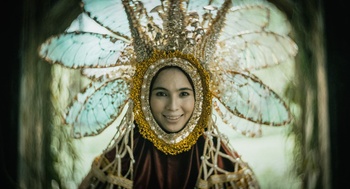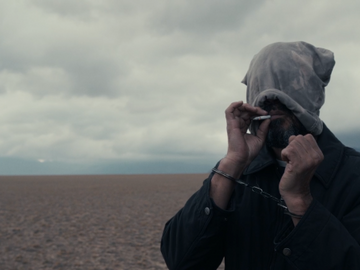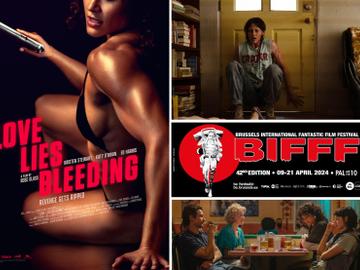This year, something more scary than leeches, serial killers or space aliens will dominate the Brussels International Film Festival: naughty children. Do we really think a disobedient child is worse than a demon? Or is there something else going on?
In 'Wolfkin', director Jacques Molitor combines the ancient myth of the werewolf with a much more contemporary fear
A ny idea what you might say if the headmaster took you aside to report that your angel had bitten or scratched someone else's angel? Would you even believe it? More than anything, do you want to know what the other kid must have done to drive yours that far?
Single mother Elaine is distraught when her 10-year-old Martin has bitten a classmate and drawn blood once again. Because of his increasingly aggressive behaviour, people are dodging them. She flees Brussels. Her filthy rich parents-in-law in Luxembourg seem to know how to handle Martin: they shave his excessive body hair, teach him to hunt and pray and, if he does not listen, chain him up.
Horror plays with our fears – the fear of being a bad parent is a deeply rooted one
You'll have to go the BIFFF – the nickname for the Brussels International Fantastic Film Festival that brings in more than 50,000 people every year – to find out the chilling ending of Wolfkin. Director Jacques Molitor combines the ancient myth of the werewolf with a much more contemporary fear. The fear of failing as a parent and seeing your child turn into an unhinged monster that threatens both you and the outside world, without being able to intervene. Could the German girls, aged twelve and thirteen, who stabbed their twelve-year-old classmate Luise to death last month, also have been biters in kindergarten? Could they have been your daughters? Very unlikely, but the fear of naughty children is real, and this fear is mercilessly explored by several films from all corners of the world. There are so many of them - at least if you count the films in which the youngsters have a lot of trauma to deal with - that the BIFFF is compiling them into a “Naughty kids” anthology.
Even on the small screen, the fusion of children and horror has reached unseen popularity. Two of the biggest hits on Netflix are Stranger Things (1980s kids with mysterious powers versus sinister governments and monsters) and The Addams Family spin-off Wednesday, with Jenna Ortega as a social pariah at a school for outcasts. She belittles bullies, plays the cello, excels in being gloomy and comes up with witty one-liners. Good girls go to heaven, bad girls go everywhere.
Child abuse
The BIFFF programme includes Kids vs. Aliens. In that American, cheap genre film, a bunch of kids left to their own devices by their workaholic parents (feel free to feel guilty) curses briskly as they indulge in their obsession with violence in DIY movies. Via the big sister, who lustily experiments with cigarettes and make-up (how dare she!), they collide with a first-class scumbag. They need to bundle all their destructive energy to fight an alien invasion. In the Polish horror comedy It Came from the Water, spoilt, giggling, hopelessly narcissistic city teenagers who are sick of lockdowns and online classes head inland to intoxicate themselves. They are punished by visiting zombies who feast on them.
In the horror-genre, there isn't always a reason why evil is unleashed on children. Sometimes they just look too cute and innocent – and that's it. Playing off the great contrast between the innocence of the child and absolute evil is a tried and tested procedure in films. Evil Dead Rise resurrects the horror franchise that started forty years ago, with Sam Raimi's legendary The Evil Dead. This time, Necronomicon does not turn people into hideous Deadites in a remote forest cabin, but in a Detroit flat. A single mother sets her sight on her own sister and three children and terrorises them with extreme violence and sadism, physically as well as psychologically. Film critics who attended the première at the South by Southwest festival speak of “'pathological violence on children” and “insane massacres”.
The monster in bed
Once again, the world needs saving from a few naughty children, those strange creatures that roam your house, disobey and are sometimes totally unaware of what is going on in their heads. One of the prototypes is Wolf Rilla's Village of the Damned (1960), impeccably reworked in 1995 by horror maestro John Carpenter. In an English village, all the women give birth at the same time. Their children grow up to be blonde angels with strange eyes who are far too smart and cold, and use telepathic powers to do great mischief.
We saw even more encouragement for not having children in Rosemary's Baby and The Exorcist, the horror classic in which an innocent sweet child wearing flower dresses suddenly turns into a swearing, puking, priest-threatening terror with a head that turns 180 degrees. Horror plays with our fears – the fear of being a bad parent is a deeply rooted one. A perniciously derailing mother-son relationship and a head that does not stay in place was also central to Hereditary by Ari Aster.

In My Mother's Skin
There is only one thing more stupid than bringing a child into the world: adopting one. There is the standard-bearer Damien, the devil child who makes his parents' lives into hell in The Omen. Adoption is also the death sentence in Jaume Collet-Serra's The Orphan. The monster does not hide under the bed. It lies in it and you tuck it in every night. It is not the heart of a family, symbol of perfect happiness, but the threat to its happiness, the reason for its disintegration.
Sometimes, there is an exciting duel between older and younger people. At the BIFFF, for instance, look out for Evil Eye by Mexican genre master Isaac Ezban. Inspired by sinister Mexican folklore surrounding witches and evil entities, he tells the tale of a thirteen-year-old, rebellious city girl who moves with her family to her grandmother's haunted mansion for the sake of her bizarrely ill sister. Her distrust of strict authority puts her in diametric opposition to her grandmother, who does not exactly live up to the cliché of the “dear old lady”. A nightmare of generational conflict that grows darker minute by minute.
Trauma and resilience
Naturally evil and possessed children are outnumbered by the children who are poorly protected in horror films. They end up paying a high price for their curiosity and naivety, they are not believed when they first smell danger or they just remind us of the childhood fears we thought we have under control. They come in handy in the eternal battle between good and evil, especially when a film explores the moment where innocence is lost. Even though this seems an inevitable step in their development toward adulthood, for the audience it remains frightening and compelling to see children lose their innocence in dark, twisted ways. Regardless of whether they are on the good or evil side, in the end.
With In My Mother's Skin by Filipino director Kenneth Dagatan, the BIFFF presents an allegedly heart-breaking, morbid and cannibalism-laced fairy tale that is being hotly hyped. A brave girl is being tested to the extreme limits. During World War II, Tala ends up with her little brother and her blood-coughing mother. They are in danger of starving, so she thinks it's a good idea to catch up with a tempting fairy. But despite its beauty, it is a terrifying entity that horrifies her mother.
It has resemblances with Guillermo del Toro's Pan's Labyrinth (El laberinto del fauno) from 2006, a sinister fairytale about the Francoist terror of the Spanish Civil War. A twelve-year-old girl eludes her sadistic stepfather in a labyrinth with a faun, giant toad and a corpulent giant with eyeballs in his palms. Del Toro showed that monsters sent on the children are not necessarily evil creatures. They can also be allies in processing trauma or defending against human harm.
The BIFFF puts on Blaze, the confronting début film by Australian artist Del Kathryn Barton, renowned for her psychedelic style. Twelve-year-old Blaze is sole witness to a disgusting rape and murder. The trial ends up being a horror show. Traumatised, Blaze ends up in a psychiatric institution against her will. By retreating into her imaginary world with a fire-breathing, feathered dragon and other wonders, she prevents herself from being destroyed by the pain she suffered in the horrific reality.
Nice, naughty, rebellious
Yet another category in genre films are the naughty children who protect us. In the Stephen King-adapted It, the kids who call themselves “the losers” join forces to take on the murderous, age-old clown Pennywise. Sometimes being naughty is okay. Or at least it works out that way. Sometimes the monsters are an opportunity to prove your worth to society. In the BIFFF's coming-of-age horror film Slash/Back, a few teenage girls have no high opinion of the culture and old ploys in their Inuit village. The arrival of bloodthirsty aliens forces them to unleash their hunter instinct.
The tagline from The Wrath of Becky is that hell hath no fury like a scorned 16-year-old. In the sequel to Becky, the orphaned heroine murders an entire battalion of homicidal Proud Boys-ish fascists with a grenade, firearm, bear trap and fighting dog. Tormented teenagers are not to be trifled with. See also Brian De Palma's Carrie, in which the daughter of a religious fanatic takes terrible revenge on her bullies during prom night.
Sometimes, naughty children are punished. Others are the hero of the day or at least admired for their rebellion, for questioning power and authority and challenging stifling or oppressive socio-cultural norms. The character of the rebellious teenage girl is at the heart of UFO Sweden, which the BIFFF describes as “a cross between The X-Files and Stranger Things.” A hacker plagued by mean foster parents and the police, searches for evidence that her father was abducted by aliens.
Born after Armageddon
Do we really think a disobedient child or rebellious teenager is worse than a demon? Of course not. The child is just a very handy character for horror films. With all these “Naughty Children” films, the BIFFF does not want to pick a fight with the youngest generations. On the contrary, the festival lures them in with a creative promotion: on 12 April, all screenings are free for anyone born after Armageddon, the very bombastic 1998 disaster film in which Bruce Willis, Ben Affleck and Liv Tyler must prevent a meteorite from destroying Earth. Have all those fear-mongering films with naughty children made the BIFFF realise that you better keep the youngsters on your side? Or is it common sense? The young people of today are the elderly of tomorrow, after all.
Read more about: Film , Events & Festivals , brussels international fantastic film festival , BIFFF , naughty children , horror



